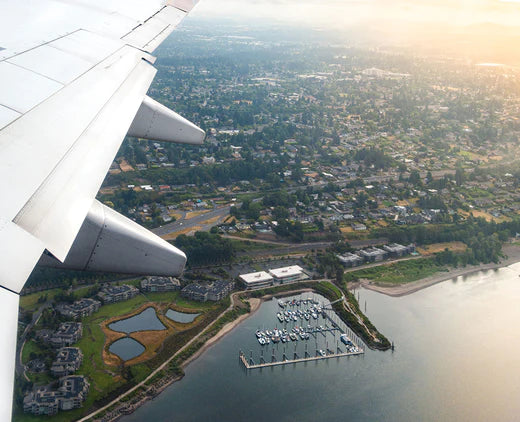A journey into the relationship between climate change and air travel.
A hundred years ago flying was mainly the prerogative of the men and women pioneering it, a lot of them military.
Then, in the 1950s, commercial air travel started to... we're not going to say it but it starts with a 't' and ends in 'f'. Back then, pilots were celebrities and air travel was still only for a privileged few who could afford it.
Now it's still a privilege certainly, but it's possible to book a flight for the same price as an expensive cocktail.
And therein lies the problem. The proliferation of cheap air travel means more planes in the sky and with them the emission of greenhouse gases, mainly CO2.

How much carbon does flying emit per year?
We go through at least around 575 million litres of jet fuel every day.
Recent figures estimate that flying contributes to 2.5% global CO2 emissions, doubling every year since the mid-1980s.
But flying impacts the climate in other, more complex, ways as well, so the overall contribution to global warming is actually higher, some 3.5%.

Business and 1st class vs economy flights
Fuel economy in aircraft is a measure of how much fuel an aircraft needs to operate in relation to a service provided and the distance between points of travel.
Let’s say you have two nearly identical jets. One has 100 fully booked economy class seats. The other has 80 economy class seats and 10 business class seats. The people in business class are responsible for a larger share of the total carbon emissions of that flight.
We hate to say it, but economy seats are also economical when it comes to fuel and, if you have to fly, you should suck it up and fly coach.
What percentage of the population is responsible for aircraft emissions?
A tiny percentage, 1% of "super flyers", are responsible for over half of aviations carbon emissions = ~1.25% of humanities total carbon emissions. This is a tiny handful of people—relatively speaking—who are responsible for the equivalent carbon emissions of hundreds of millions.
For some perspective, even a short-haul return flight from London to Edinburgh contributes more CO2 than the mean annual emissions of a person in Uganda or Somalia.
What about airplanes powered by renewables?
Some day we may have planes that fly on either hydrogen or electricity. Many are predicting that we are at the cusp of a change in air travel right now, but more work needs to be done to push this technology forward.

Do I need to stop flying?
If you want to, you can. Maja Rosén did. She started a movement called We Stay On The Ground (“Vi håller oss på jorden”) to help spread awareness about the impact flying has on climate.
There are plenty of other ways to get around.
But we know that is a big thing to ask. Why should YOU stop flying or try to log fewer air miles? Fundamentally, it's a moral dilemma we all face.
Can I climate compensate and continue to fly?
It certainly can help.
Simply put, a carbon offset is something you create that absorbs greenhouse gasses in an equal amount to what you released. It’s like eating a cupcake and then running for 2 hours on a treadmill.
Carbon offsets are a way of keeping the economy stable while still improving sustainability. One example of a carbon offset is planting a tree. The exact amount of carbon dioxide one single tree offsets varies depending on who you ask, but one figure that seems fairly common in the literature is that one tree offsets 0.16 tonnes CO2.
To get the right kind of offset you need to calculate the carbon emitted. For example, if you go to the Delta Airlines website you can find their “Carbon Calculator." You can then purchase the correct size offset from a company that sells them.
It’s not perfect but, it’s a start.
Comparable with sweating it out on the treadmill to offset the cupcake, the problem is that once CO2 has been put into the atmosphere it takes time and more energy to remove it. Therefore, it's always better to reduce emissions upfront.





























